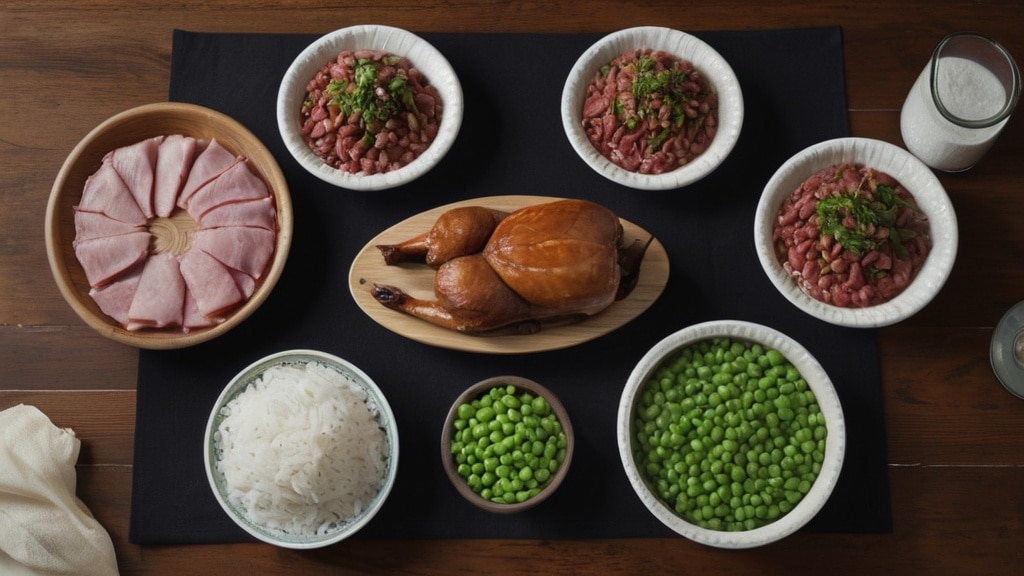I’ll never forget New Year’s Day at my granny’s house in Charleston. She’d have a big pot bubbling away on the back burner—black-eyed peas, rice, fatback, maybe a bay leaf if she was feeling fancy. The smell alone could wrap you up like a quilt. “Eat your peas,” she’d say, “they’ll bring you luck.” I didn’t care about luck. I cared about that earthy, smoky flavor that made me close my eyes every time I took a bite.
Hoppin’ John ain’t just food. It’s history. It’s memory. It’s a deep-rooted tradition that started in the Lowcountry and spread its way across kitchens all over the American South. This humble dish of black-eyed peas and rice is deceptively simple—but when it’s made right, oh man, it sings.
At its core, Hoppin’ John is black-eyed peas cooked with onion and pork, served over fluffy white rice. Sounds plain. But the magic lies in the layering. The slow simmer. The fat. The seasoning that seeps in and doesn’t let go. It’s comfort food with a backbone.
What Makes It Special
You’re not just eating peas and rice. You’re eating the story of the South. African influence, Gullah roots, survival food turned celebratory dish. It’s eaten on New Year’s for good luck, but truth be told, it should be eaten all year long. When done right, it’ll make you rethink everything you know about peas.
Let’s talk ingredients.
Ingredients & Substitutions

Black-Eyed Peas (2 cups dried or 4 cups cooked)
Go dried if you can. Canned works in a pinch, but you’ll miss the starch and flavor that develops during a long simmer. Soak dried ones overnight, or use a quick boil method if you forgot.
Smoked Pork (1–1½ cups chopped)
Traditionally, it’s ham hock or fatback. Bacon will do, especially thick-cut smoky stuff. Smoked turkey legs are a solid swap for pork-free folks. Even mushrooms (shiitake are gold here) can work for a veg version if you give ’em a hard sear first.
Onion (1 large, diced)
Yellow or white. Don’t skimp. It’s the base of flavor.
Celery (1 stalk, diced)
Optional but adds depth. Gives you that trinity feel without going full-on Cajun.
Garlic (2–3 cloves, minced)
Fresh only. Powder won’t cut it.
Bay Leaf (1–2 leaves)
Subtle but brings it together. Don’t skip unless you have to.
Thyme (1 tsp dried or 1 tbsp fresh)
Fresh thyme is better—peppery and floral. Dried works, but add it early.
Cayenne or Red Pepper Flakes (½ tsp or to taste)
This is where you get that Southern kiss of heat. Adjust based on who’s at the table.
Salt & Black Pepper (to taste)
Season gradually. Black-eyed peas can be bland if under-salted.
Chicken Stock or Water (4–5 cups)
Stock adds more depth. Homemade? Even better.
Long-Grain White Rice (1½ cups uncooked)
Carolina Gold is the Cadillac of rice here if you can find it. Otherwise, jasmine or plain ol’ long grain will do fine.
Scallions or Chopped Parsley (for garnish)
Add some green. It brightens it up.
Step-by-Step Instructions
1. Start with the pork.
Render your bacon or brown your ham hock in a heavy-bottomed pot. Cast iron or Dutch oven is your friend here. Get it good and crispy or golden—this builds your flavor base.
2. Add your aromatics.
Throw in the diced onion, celery, and garlic. Sweat them out till they’re soft and smell like heaven. Don’t rush this part. You want them to get a bit golden on the edges.
3. Stir in your peas.
If using soaked dried peas, add them now. Canned go in later. Stir to coat with the fat and onions.
4. Season and simmer.
Add bay leaves, thyme, cayenne, salt, pepper, and your liquid—just enough to cover the peas by about an inch. Bring it to a boil, then drop the heat and let it simmer. Lid on, but cracked a bit.
5. Wait. Watch. Taste.
Simmer 45 minutes to an hour for dried peas. Taste often. They should be tender, but not mush. Canned peas? Toss them in the last 15 minutes.
6. Cook your rice.
While the peas do their thing, cook the rice. Rinse it well before cooking—it helps keep it fluffy. One part rice to two parts water, bring to a boil, cover, lower heat, and don’t peek.
7. Put it all together.
Some folks mix the peas and rice. Others serve peas over rice like a stew. Both are right. Depends on the day and the mood.
8. Finish with fresh herbs.
A sprinkle of scallions or parsley on top adds just the right pop.
Expert Tips
– If your peas are chalky, they’re undercooked. Add water, keep going.
– If they’re too salty? Add a chopped raw potato. It’ll soak it up.
– Want a creamier texture? Mash a spoonful or two of the peas against the pot wall and stir it in.
For a smokier version, toss in a smoked paprika or a dash of liquid smoke. For more heat, slice up a fresh jalapeño and sauté it with the onions.
Cooking Techniques & Science

Why the pork first?
Rendering fat pulls flavor into the base. Think of it as the Southern sofrito. That smoky fat coats everything that follows.
Why not mix the rice in the pot?
Rice loves to soak up liquid and can go mushy fast. Keeping them separate lets you control the texture better.
Why dried peas over canned?
Dried peas soak up flavor while they cook. They’re cheaper, more traditional, and give you control over texture. Canned peas tend to fall apart if cooked too long.
The science of layering
You’re building flavor from the bottom up. Browned meat = umami. Onions = sweetness. Spices = complexity. The slow simmer pulls it all together and makes it stick to your ribs.
Key Tools
A heavy-bottomed Dutch oven gives even heat and retains it. A fine-mesh sieve is useful for rinsing rice or draining canned peas without losing them down the sink.
Serving & Pairing Suggestions
Hoppin’ John pairs perfectly with collard greens. The bitterness of the greens cuts the richness of the peas and pork.
A side of cornbread? Absolutely. Get that golden crust on the skillet side.
For drinks, sweet tea keeps it classic. A dry cider or a pale ale cuts the fat beautifully.
Plating? It’s a rustic dish, so don’t overthink it. Bowl, spoon, steam rising. Maybe a lemon wedge on the side if you’re feeling bold. A drizzle of vinegar on the peas? That’s old-school charm right there.
Conclusion
Hoppin’ John is more than just a lucky New Year’s dish. It’s a dish that’s stood the test of time. Cheap, nourishing, endlessly adaptable. It’s soul food in every sense of the word.
Whether you’re using ham hock or mushrooms, whether it’s January 1st or July 4th, making Hoppin’ John connects you to a history of resilience and flavor.
Let the peas be tender, the rice be fluffy, and the pork be proud.
FAQs
1. Can I make Hoppin’ John vegetarian or vegan?
Yes! Use smoked paprika, seared mushrooms, or smoked salt to mimic the pork’s flavor. Vegetable broth adds depth too.
2. Can I freeze Hoppin’ John?
Sure can. The peas freeze beautifully. Just keep the rice separate for best texture when reheating.
3. What’s the difference between Hoppin’ John and just peas and rice?
Hoppin’ John has that slow-cooked depth, smoky meat, and traditional seasoning. Peas and rice is the blueprint—Hoppin’ John is the soul.
4. Can I use other beans instead of black-eyed peas?
Technically yes, but then it ain’t Hoppin’ John. Crowder peas or field peas are closer cousins. Kidney beans? That’s a whole other dish.
5. Why do people eat it on New Year’s Day?
Tradition says black-eyed peas bring luck, rice brings prosperity, and greens (if you serve them) represent money. It’s a Southern superstition one that tastes pretty dang good.

